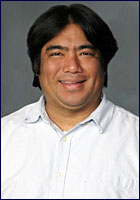Moon festival
This is the Mid-Autumn festival, supposedly the night that is ideal for gazing at the moon. Either that, or that was last night--I don't know which.
People eat moon cakes in recognition of the holiday. They don't taste like cake, per se. They are sweet--kind of. They have a yellow "yolk" in the center and as you eat it, it looks like a moon.
Anyway, I'm not sure whether the moon is supposed to be closest to the earth, or brightest in the sky, but I'm pretty sure you can look this info. up in an astronomical ephemeris, and it won't follow the Chinese lunar calendar. But whatever. Here is a picture of the moon.

For some context, I took a picture through a railing on a nearby building:
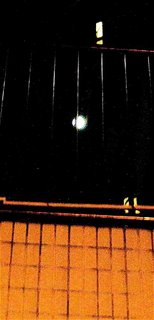
Now, doesn't it look brighter or bigger than usual? If not, turn up the contrast on your monitor or get a bigger and brighter monitor. For good measure, copy it onto your desktop and use photoshop to make it bigger and brighter. Now is it bigger or brighter than usual? Good.
Happy mid-Autumn festival!
More pictures from Vietnam
I decided it would be easier for me to post all my pictures with short captions now, and post a more serious piece later. Partly this is because of requests for pictures, and partly it is because my internet connection at home is so slow, blogger times out when I try to upload pictures from there. So while I'm still at work I should upload the pictures.
First,
Cao Dai, a religion homegrown in Vietnam in the early 20th century, who see themselves as a successor to Christianity, Judaism, Islam, Hinduism, Buddhism, Taoism, and Confucianism.


There are various levels here: while most wear white, there are those who wear other colors to represent various Asian religions: red for Confucianism, yellow for Buddhism, and blue for Taoism. This worship happens 4 times a day: 6am, 6pm, noon, and midnight. We saw the service at noon. People go through various bowing motions on the floor as a choir and orchestra chant.

Our tour guide says it's in Vietnamese but though he's a native speaker, he can't understand what they're chanting. The symbol they use is the all-seeing eye of God, just like on the dollar bill:

These eyes follow you as you walk by them.
Cao Dai does seances, and this is their main source of religious knowledge. Through these seances they contacted various people from the past, including Sun Yat Sen (founder of Modern China) and Victor Hugo (author of Les Miserables). Here they are, as saints, pointing the way to Cao Daism.


A bit out of order chronologically in our tour, but while I'm on the subject of religion, here's a Buddhist temple. This is Theravada Buddhism, in a Khmer community. North Vietnam has a bunch of Mahayana Buddhism. That bookcase has a bunch of books in English, including one on Zen, which is NOT Theravada Buddhism. Vietnam seems to be a place where different religions get along a bit better than in other places.

Khmer youth all train in a Buddhist temple until they turn 18 and decide whether to remain monks or not.
Notre Dame Cathedral in Saigon:
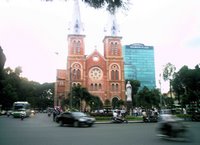
This is during a service. Note the crowd around, some trying to get in, Others feel it's a party. Note the balloons being sold on the lower left.
Next: During a service. It was packed. Service in Vietnamese. I tried to be discreet so I didn't use flash and couldn't get a good angle.

Meanwhile I hear singing across the street. I go and find a kind of Sunday school class, I suppose. It's next to a Catholic bookstore. I know it's Catholic because it's featuring books like these:

But it also has books like these:

Steven Covey, of "Seven Habits of Highly Effective People" fame (here's one for teens) is, of course, Mormon. But, as I said, in the atmosphere in Vietnam, Catholics and Mormons get along fine together.
Here's another look at the church. Lots of traffic. Takes lots of practice to cross the street.
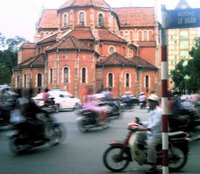
Motorbikes everywhere. Worse than in Taipei. And not all of them are experienced drivers, either. Sometimes a whole family is riding one. They follow traffic lights, but as a pedestrian you often can't see them lights. There are often no crosswalks. Luckily no one is really speeding, so you can do quick negotiations with each driver as you approach collisions.
Here's rush hour going to the airport:
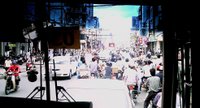
On another topic, we toured the Mekong River delta. No one knows how long it is because its source is somewhere in the inaccessible Tibetan plateau. But it brings lots of rich silt and periodically floods the river delta, depositing fresh fertilizer every year. Farmers just plant, sit back, then harvest. They still do that. Not because it's quaint--it's still a viable way to make a living. They only make about a dollar a day, but they grow their own food and live on boats. It's apparently a viable way of living. We toured by boat.
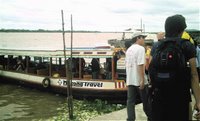
There was some rain, but not the sort you would associate with a hurricane. We got more water splashing up from the river. Not comforting to think how many countries the Mekong goes through to get to us, and how polluted it might be. Some have a different attitude than others:
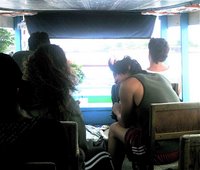
That's Sangi in the front right, basking in the water, stretching out his legs, having a good time. YiChieh is behind him, using him as a shield and crouching to avoid getting any of that dirty water on him.
As the weather gets nicer, students relax on the bow:

And we eventually get two human prows, looking out over the bow:
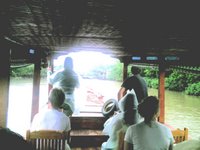
Here is a floating market, where people buy and sell from boat to boat:

A view from the floating market to the houses on land. Lots of TV antennas. The guide says that ever since they had something new to do at night (watch TV), the birth rate has gone way down.

They pop rice, just like popcorn, in a big skillet:
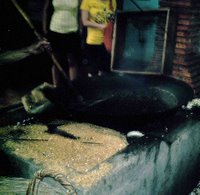
We handled a pet python at a restaurant on one of the islands:

And we walked on rickety bridges.

Well, not rickety, really, but you have to watch your step and the railing is only on one side. They call these "monkey bridges" because you have to be a monkey to cross them. I'm proud of Priscilla here, especially. Who would have thought she'd agree to this?
Speaking of monkeys, you can feed a monkey at a rest stop on the way to the Mekong:

At the same stop, a truck pulled up with a tarp on the bottom, filled with water, and live fish. Here's someone bucket brigading the fish into bags.
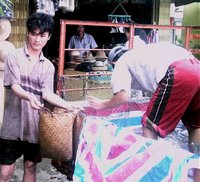
We see Mt. Ba Den on the way back from the Cao Dai temple and the Cu Chi tunnels (yes, these pictures are out of order).

Those are rice paddies in the foreground. The canal is an irrigation ditch. Sangi hops across one:
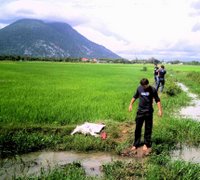
and loses one of his slippers:
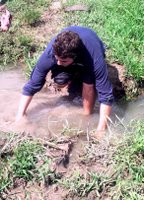
The response back at Pepperdine's International Programs office is, "What's he doing without close-toed shoes in an Avian Flu-infested area?!" But I trust our tour guide Viet, who keeps up on these things, and when he says you can wear sandals, I go with that. Mind you, he didn't think Sangi was going to wander into a rice paddy. But we did cancel our tour of the aviary because of a recent case (in a bird, not in a human) there. It's been over a year since there's been a human case of Avian flu in Vietnam, mostly because the government has been very quick to react to it.
Don't worry about his slippers: Sangi got another pair at a market later that day, and probably paid less than a dollar for it.
Here are a couple of flower vendors pedaling on the highway who stopped to see the commotion about the slipper:
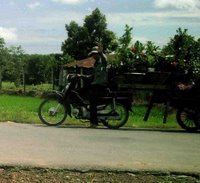
Now for miscellaneous: Across the street from where we stayed in Saigon is a youth activities hall of some sort, that has the internet cafe where I had trouble typing because of the Vietnamese accents that kept coming out. Still, it was a few cents an hour.

They also have concerts. This one was from Sunday night. They did a bunch of Western pop songs, Vietnamese style.

There weren't many people inside at the concert. More of them were outside, peering in through the front gate. Perhaps they couldn't afford admission. I don't know. But they were really into it. I wonder if maybe the bigger party was happening outside than inside.
Okay, I've got the pictures from Vietnam up now. Now I can post even when I'm at home without worrying about how long it will take to upload.
Vietnam, part I
Okay, this may not be part 1 because I posted something while in Vietnam. But this is the first post after I got back, and more importantly for Prof. Williams, the first post with
pictures from Vietnam.
Of course I had gotten slightly behind in my work when I left and did not make any progress while there, and since I'm giving a test tomorrow, I spent much of the past few days catching up with grading, writing the test, and doing a bunch of administrative work unrelated to either, but related to the Hong Kong program. Anyway, it's 11:28 pm on Wednesday, and this is the first time I have to post anything from the trip.
We arrived last Thursday on Cathay Pacific into Ho Chi Minh City (still known as Saigon to locals but all the official documents say "Ho Chi Minh City"). We had Pho. We toured the city. Here's a statue of Ho Chi Minh (known as "Uncle Ho"), welcoming a child.

We saw statues of Ho Chi Minh
everywhere. In this case, I went around to see what Uncle Ho was looking at. He gazes at bright lights in highrise office buildings.
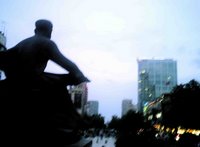
The tall one on the right says "Citibank". The bright lights on the lower right come from what was once the Russian market, but now offers a lot at very low rates. "Motorola", say signs emblazoned on its windows. Even the little guy is in on it. The middle pedestrian is rolling some kind of toy that makes clacking noises as it moves, drawing attention from tourists who might want to buy such a thing. Cheap price! And Uncle Ho sits there, contented.
After all, all Ho Chi Minh wanted was the best for his country. And now his country has discovered that free markets are just what are needed.
I say that with only a little irony. Because it's very clear that Vietnam suffered under communist strictures, and now is flourishing under the free market. There's now a sizeable middle class that has food and clothing and shelter, where once such things were in short supply. They're at restaurants. They frequent massage parlors. They buy brand name clothing at shopping malls and hang out at popular rock concerts. Young couples find secretive places in parks to snuggle, but with so many of them, the general activity is not so secret.
In the 1980s, Vietnam adopted a policy known as "Doi Moi", or "renovation", adopting, like China, a "one party, free market" slogan. And it's worked. I saw prosperity and freedom, though I knew of course that they were not a democracy. But as has often been pointed out, most people don't go for ideologies. They want to live normal lives. They want to enjoy life, and raise their families without fear of danger or deprivation. They want to eat their favorite foods and sleep at home near their spouse and children. And, it seems, many Vietnamese can do just that.
They keep comparing themselves to other countries. If China can get all this foreign investment, so should they! If Singapore is the Asian financial dragon, then the Vietnamese, children of the dragon (or so the legend says), will one day surpass Singapore.
There's also poverty. Kids pushing roses on men walking with women, through the night, a necessary job to put food on the table. People at the river, cleaning plastic bags they salvaged from the dump so they can sell it to recyclers. But under communism, they didn't even have these opportunities. Our tour guide, Viet, lived through both times, and he said they have a saying: Under capitalism they share wealth. Under communism they share poor [sic]. I don't know if people really share now, but it's hard to deny that the people overall seem to be living a better life today.
The next day we went to the Cu Chi tunnels. These were tunnels by the Viet Cong in the jungle to subvert the South Vietnamese and US forces during the Vietnam War (and before that, in their struggle for independence against the French).
They were too small for most American soldiers to crawl through, though it was fine for our Blair Warner:
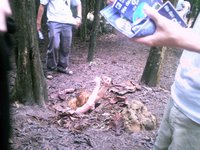
They had a section of tunnels widened for tourists so we could all go through, even if we weren't Blair Warner:

A display of some of the booby traps used:
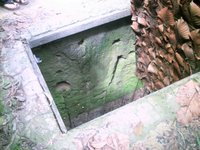
And a war trophy: a dismantled US tank, left in the jungle, to be a tourist trap for a later generation of US citizens:
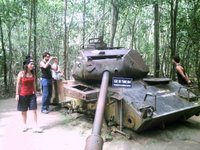
On the left is Andrea Rodriguez, then Jonathan Hippensteel, and right behind him is Andrew Fay. On the right is Alejandro Sangiovanni.
Young mothers would keep US tanks from going into the jungle, saying that to go into the jungle, "you will have to run over me, a mother. You will have to kill your own mother."
There's something democratic about every system of power. No one can be in power with no support. The most disciplined army in the world executed their own Emperor Nero when there was no one left to support him. The Chinese emperor Qin Shi Huangdi maintained control through horrific tyrannical methods, but by the time he died, there was sufficient unrest to dismantle his empire. The fact that women would throw their bodies in front of tanks shows that there is always some way to stop a tyrannical regime if enough people want to badly enough.
I actually predicted (without knowing specifics) back when we invaded Iraq in 2003 that there were probably many in the minority who supported Saddam. We can't know that based on the elections, rigged as they were. But we can know that because otherwise, Saddam's own private Republican Guard would have killed him. Well, I didn't predict they would be a problem for American armed forces this many years into the conflict, but I did predict they represented a sizeable chunk of the population.
I said there's "something democratic". It's possible to rule with a minority. But it can't be too small of a minority or you won't be able to pull it off.
Well, the moment many of the students were waiting for: the opportunity to shoot Vietnam War era weapons. AK 47s, M16s, M60s, all mounted and ready for tourists who are willing to shell out USD $1 a bullet. All left over from the war, in perfect working condition, firing every day for thousands of trigger-happy tourists.

Sangi (Alejandro Sangiovanni, one of our students) gets set up for shooting at the range.

Delia shoots. She gets ear mufflers. Priscilla (lower left) doesn't. Ouch. Those are loud.
This was by far the single biggest event we were all hoping for when we came to Vietnam. But by the end of the tour, we saw so many other things that although this was definitely up there as an attraction, other parts of the trip wowed us just as much.
More on those in my next post tomorrow.








































